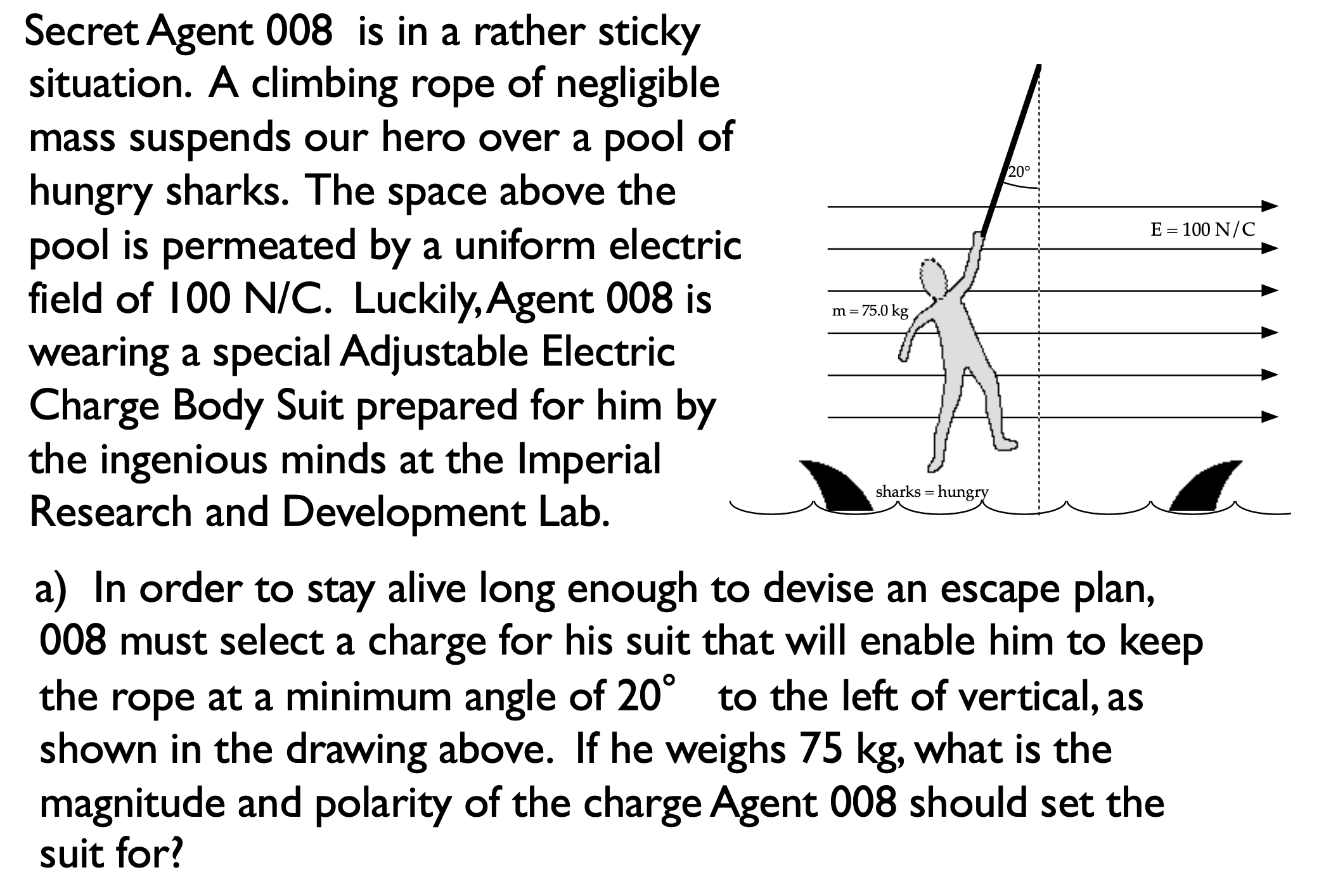
Chapter 5: Electric Charges and Fields
5.0. Overview
Our study of electricity and magnetism begins with one of the fundamental concepts in nature: the charge. You've certainly heard of positive and negative charges, have been shocked by "static electricity," or rubbed a balloon on your hair and seen it stick to a wall. All of this has to do with electric charge, and the electric fields that surround charges.
Let's get started!
- Electric Charges and Coulomb's Law
- Electric Fields, Charge Distribution
- Drawing Electric Field Lines
- Motion of a Charge in an Electric Field
5.1. Electric Charges and Coulomb's Law
5.1.1. Franklin, an American scientist
Static (non-moving) electricity was studied by a number of people in history, including Benjamin Franklin (1706 - 1790), who was able to determine that items could be identified as having one of two charged states, which he elected to call "positive" and "negative."
Based on his experiments, he determined that "like charges repel, opposite charges attract."
We can repeat some of his experiments using 3M Magic Tape.

He also discovered the principle of Conservation of Charge: "The net amount of electric charge produced in any process is 0." For example, if a glass rod is rubbed with a piece of silk (a common experiment back in the day), the rod acquired a negative charge and the silk was left with an equal amount of positive charge.
5.1.2. Electric charges in context

The nucleus of an atom contains positively charged protons and neutrally charged neutrons, which each have a mass of ~1.67e-27 kg.
The nucleus is usually surrounded by a quantity of negatively charged electrons, which each have a mass of 9.11e-31 kg.
In its neutral state, the atom has an equal number of protons and electrons. If the atom gains or loses electrons, it is called an ion. An atom that gains electrons has a surplus of negative charge and is called a negative ion, while an atom that loses electrons has a deficit of negative charge and is called a positive ion.
5.1.3. Conductors and Insulators

Conductors are metals (copper, gold, aluminum, etc.), which conduct charges easily. In these materials, the negatively-charged electrons (e-) are not very tightly bound to the nucleus of the atoms.
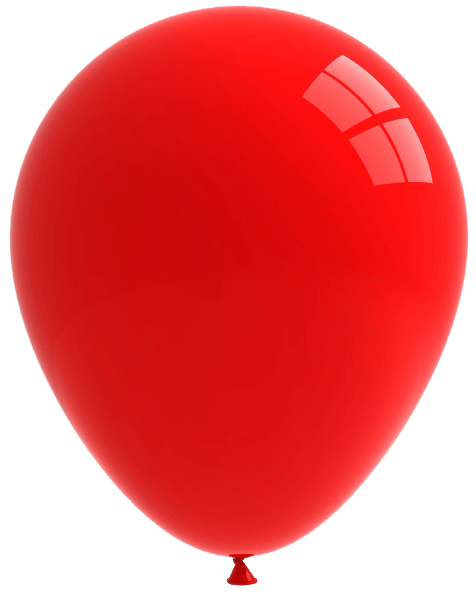
Non-conductors, or insulators such as rubber, plastic, or wood, don't easily conduct charge. Their electrons are more tightly bound to the nucleus of the atoms.
Semiconductors may or may not conduct electric charge, depending on other conditions. (These aren't covered in this course.)
5.1.4. Movement of Charge
Franklin developed the idea of "positive" and "negative" charge as a way of accounting for charge transfer, but the actual mechanism for transferring charge (electrons) wasn't known at the time. We now understand that electrons, which are negatively-charged, can move through a conductor, and can be transferred from one body to another. It's the electrons that are moving, even if we commonly talk about the movement of positive charge. Positively-charged protons are bound in the nucleus of an atom—they don't move.
When we talk about the motion of charges, if we talk about the "movement" of positive charge, we are actually referring to the movement of negative charge (electrons) in the opposite direction.

We will be discussing the continuous movement of charge—current—later on in this course. For the time being, we'll be looking at static situations, in which charges may quickly move from one place to another, but then quickly establish an equilibrium in that new situation.
5.1.5. Charging by Conduction
"Charging by conduction" occurs when a charged conductor (metal) touches another conductor with a different amount of charge: some free electrons pass from one object to the other.
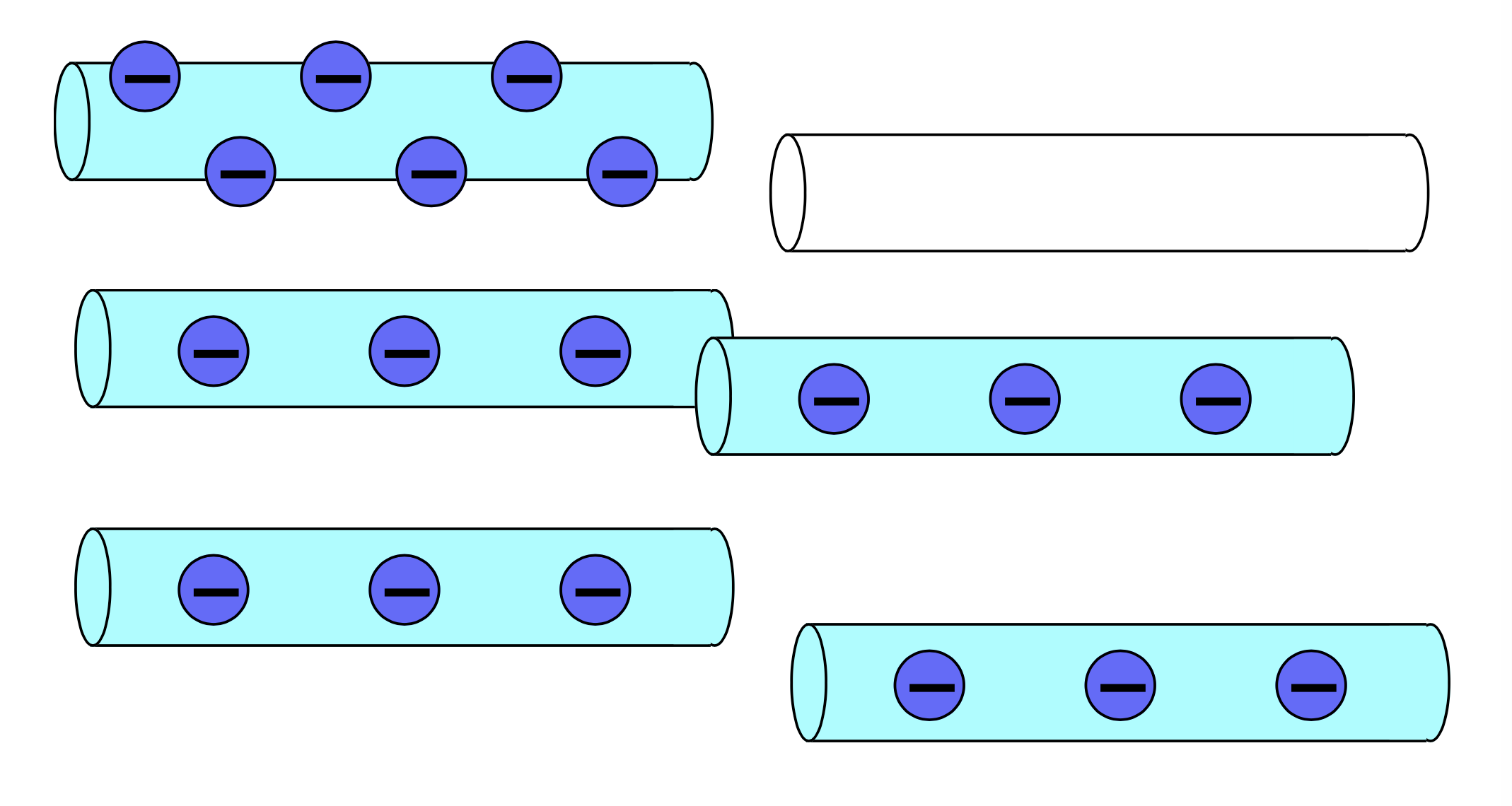
The same thing can happen in a "positive charge" context. In examining the "transfer of positive charge," which isn't what really happens, it may help to think of the positive charges as "electron holes," a location in the atomic structure in which an electron has been temporarily displaced. If an electron from the right side moves in to fill the hole, it vacates another location: the "electron hole" has moved to the left.
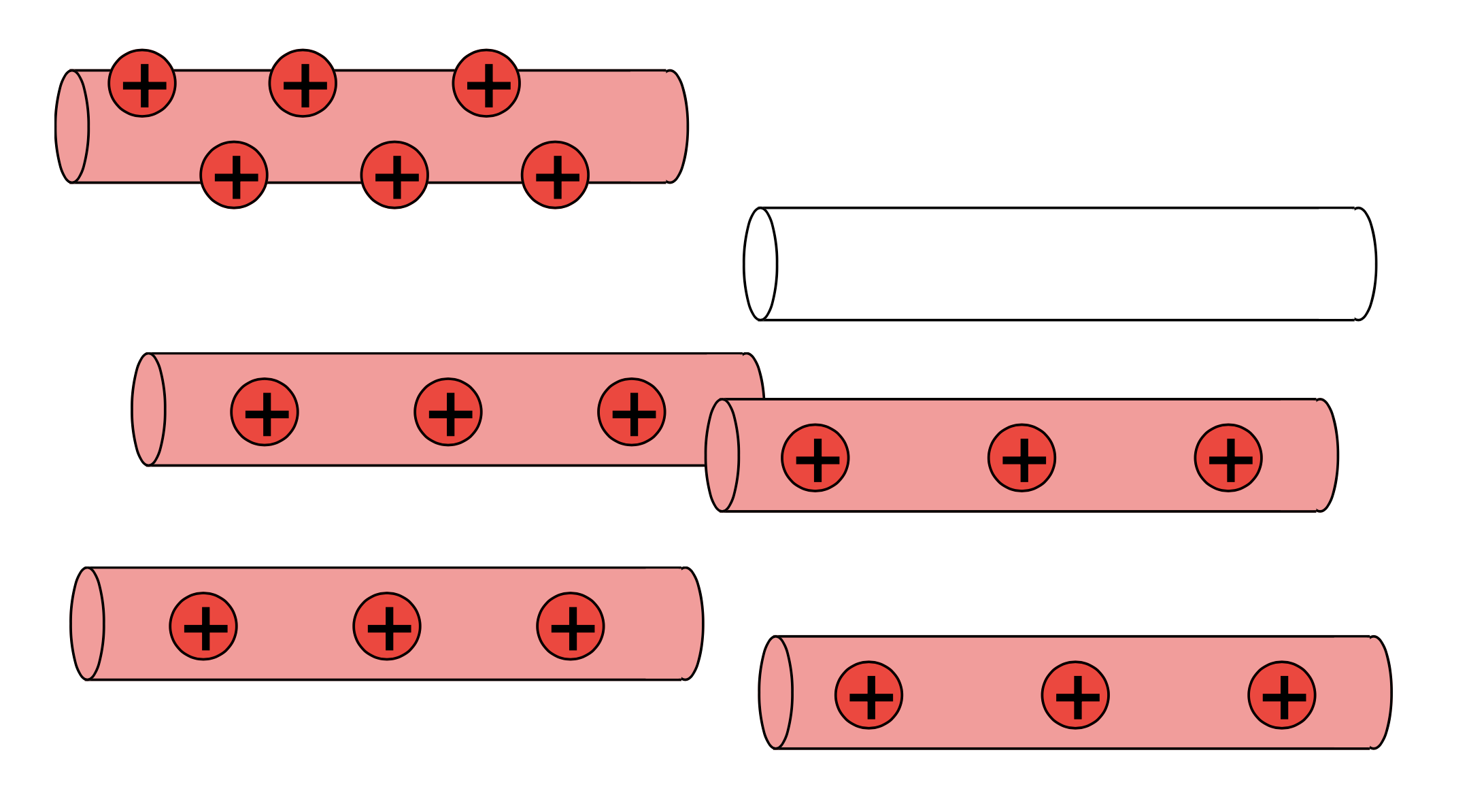
5.1.6. Charging by Induction
"Charging by induction" occurs when a charged object is brought near a neutral conductor. Charges in the conductor become polarized in response to the nearby rod.
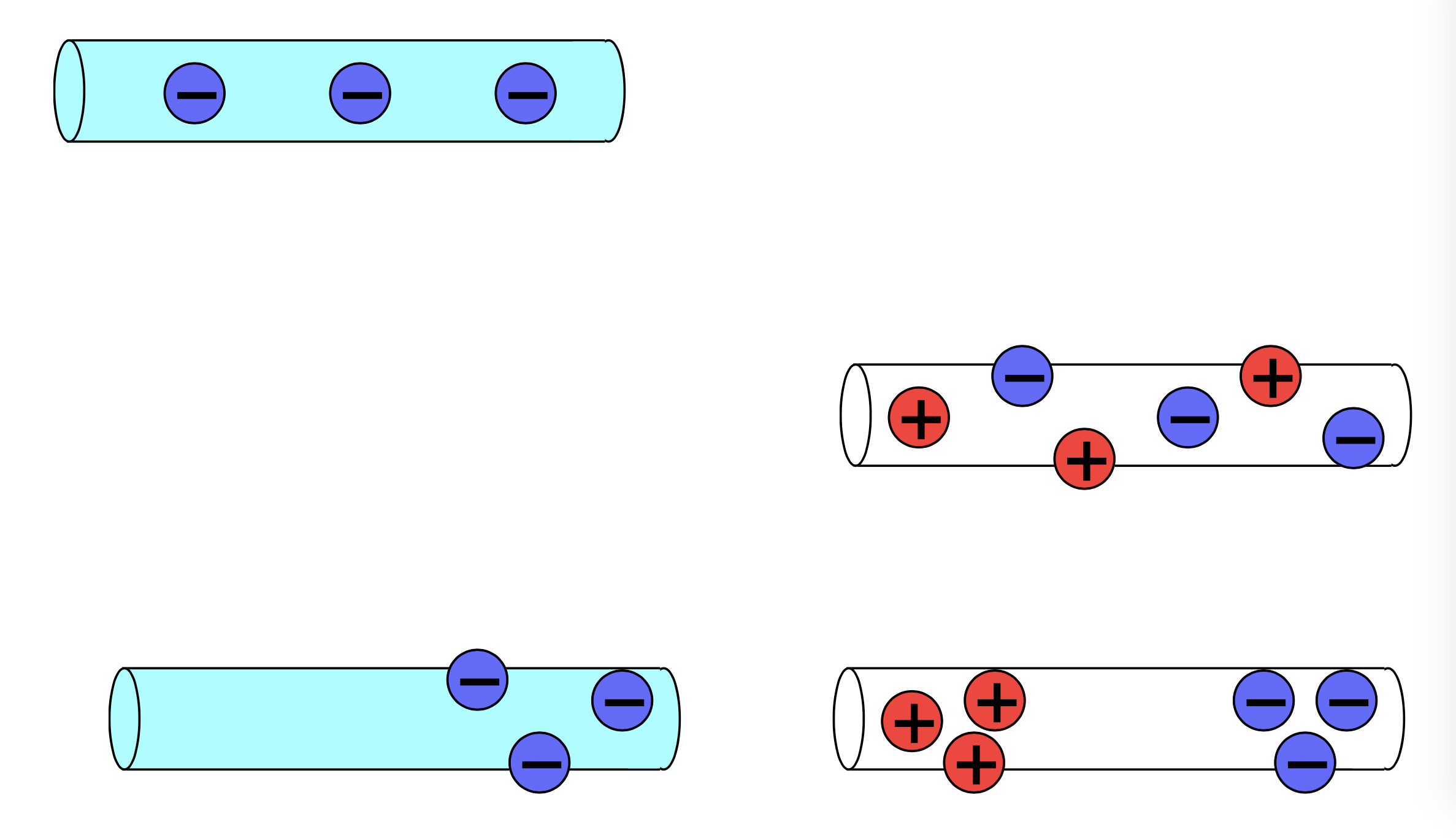
5.1.7. Grounding
The term grounding refers to connecting a conductor to the literal ground, ie. the earth. The earth readily accepts or gives up electrons—it has plenty to spare—so grounding a conductor allows for the flow of charges. What effect this has depends on the situation.
On a smaller scale, a human being can act as a ground, touching a conductor and accepting or giving up some number of electrons, depending on the situation.
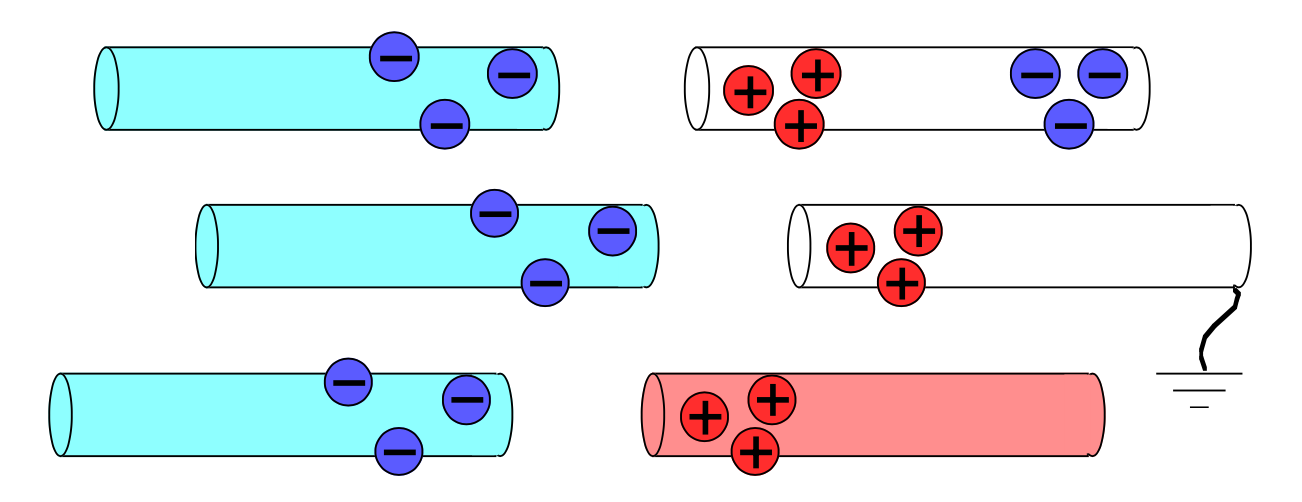
5.1.8. The Electroscope
The electroscope is a simple device designed to detect the presence of electric charges. Movable leaves of gold leaf or some other light conductor are connected to a metal ball and enclosed in a jar to isolate the leaves from air currents. When a charged object is brought near or touched to the ball, the leaves separate. But why?
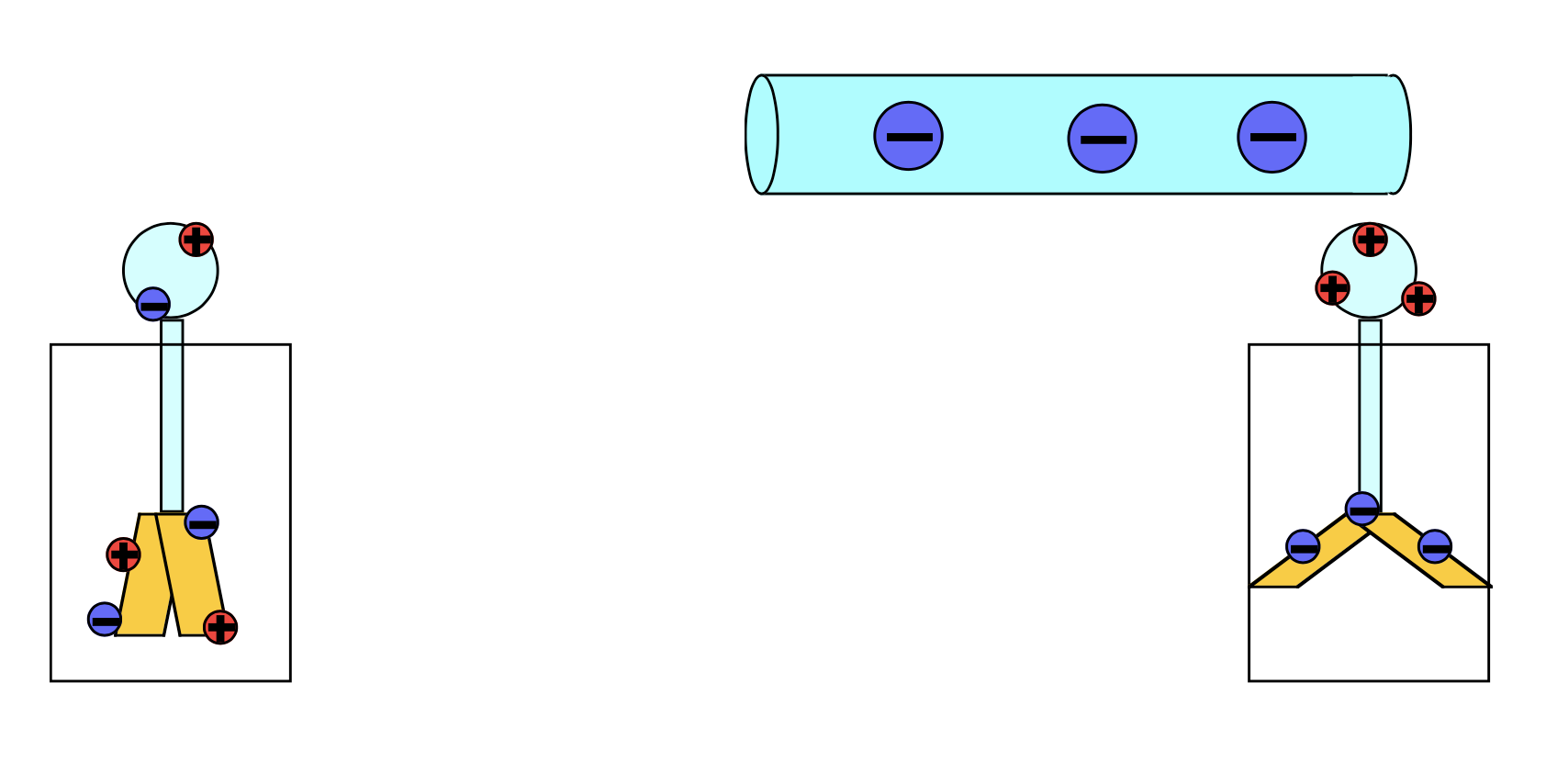
5.1.9. Explorations
This short video excerpt from the excellent Mechanical Universe series summarizes some of the important concepts we've just covered.
This simulation allows demonstrations the transfer of charge and the resulting effects on the charged bodies.
5.1.10. Coulomb's Law
In addition to being able to predict what happens to charge objects qualitatively, we'd like to be able to analyze the behavior of charges quantitatively.
In 1785, based on experiments he had conducted, French physics Charles-Augustin de Coulomb published what came to be known as Coulomb's Law.
Coulomb's Law
The vector force between two charges is described by the equation:
- F21 = the force on charge 2 from charge 1
- k = the electric constant 8.99e9 N m2/C2
- q1 and q2 = the charges in Coulombs, a positive or negative value
- The charge of a single electron is -1.602e-19 C
- The charge of a single proton is +1.602e-19 C
- r = the distance between the two charges
= the unit vector that points from charge 1 towards charge 2
By carefully considering the direction of and the signs of q1 and q2, one can arrive at the direction of force between the two charges: a positive-force indicating a repulsion between them, a negative-force indicating an attraction between them.
In practice, many people simply calculated the magnitude of the electric force and then determine direction according to the specifics of the problem given.
Coulomb's law describes the force of attraction or repulsion between two charges. If there are more charges in a given region, the net force acting on any given charge will be the vector sum of the forces from the others. This often means you'll need to consider x and y components of those forces.
Electric force between two people
Two students stand 1.5 meters apart from each other. One has long hair, and in recent brushing he removed 5,000 electrons from his body. The other student has short hair, and brushing her hair removed 1,300 electrons.
What is the net charge of each student? Are they electrically attracted or repelled? What is the magnitude of the electric force between them?
The first student has lost electrons, and so has a net positive charge. To identify the amount of that charge:
The other student, using a similar calculation, has a charge of 2.08e-16 C, and because they are both positively charged, they experience an electrical force of repulsion. How big is that force, when they are separated by a distance of 1.5 meters?
This is an exceedingly small force. :)
Multiple charges

Draw a free-body diagram for the forces acting on the -12μC charge in this figure, and sketch in the net electric force for that charge. Then calculate the force (magnitude and direction) acting on the -12 μC charge.

There are forces between all three charges in this situation, but we've been asked to focus on the forces acting on the -12 μC charge in the upper right. Our free-body sketch for the forces acting on that charge include a force of repulsion upwards from the negative charge below it, and a force of attraction down and to the left from the positive charge. That force of attraction is weaker because that charge is farther away.
Because these particles are not in a line, we need to do a 2-dimensional analysis that includes x and y components. The analysis below begins by breaking up the forces into their components, and applying Coulomb's law to those x and y situations.
The 5.0 N force needs to be broken up into components based on the angle of that force. Let's get that angle, then get the components:
And with all x and y components identified, we can add them to get the components of the resultant:
... and then we resolve them into a final magnitude and direction.
A quick check with our free-body sketch confirms that this is the expected direction.
5.1.11. Visualizing electric forces from point charges

Go to www.compadre.org/Physlets/ and run some simulations to get a better understanding of the forces that charges can exert on each other.
5.2. Electric Fields, Charge Distribution
We have recently talked about the force of gravity acting on a mass in the vicinity of another mass, and we've made reference to a "gravity field," which can exist in a region of space. Put a mass in the gravity field and it will experience a gravitational force.
In the same way, an electric charge produces an electric field in the space around it, and charges in that field experience an electrical force.
Let's learn a little about how all that works.
5.2.1. Electric fields from point charges
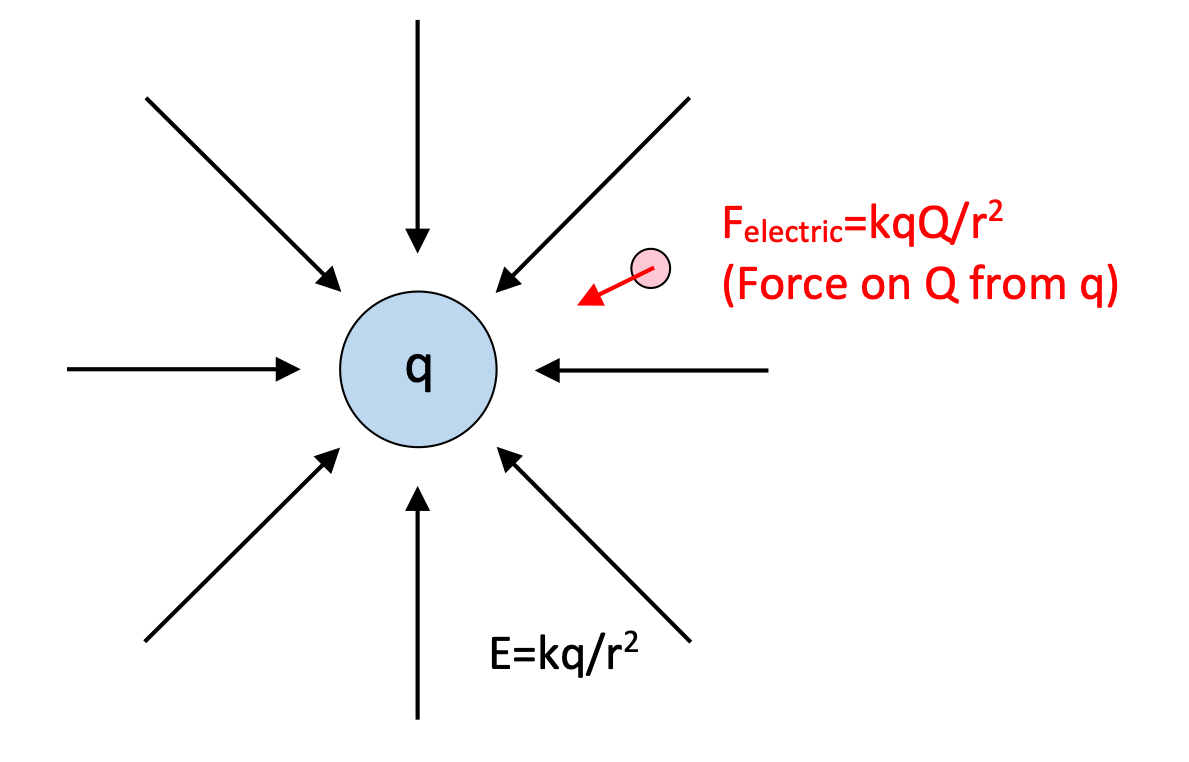
In the diagram here a very small positive charge Q (pink-colored) is in space in the vicinity of a negative charge q (blue-colored), and experiencing an electrical force of attraction as described by Coulomb's law. (Those two charges are also experiencing a gravitational force of attraction based on whatever mass they have, but in most circumstances the electric forces acting on bodies is much stronger than the gravitational force, so we'll ignore gravity.)
The definition of Electric Field
If we take the electrical force experienced by the positive charge and factor out its charge, we're left with a different equation, one that no longer describes the Force on that charge big-Q, but the field around little-q.
This equation describes the magnitude of the electric field. The direction of the electric field is defined as the direction felt by an "always-positive-test-charge," placed into the field to check its direction. Whichever direction the net electric force acts, that's the direction of the electric field at that point.
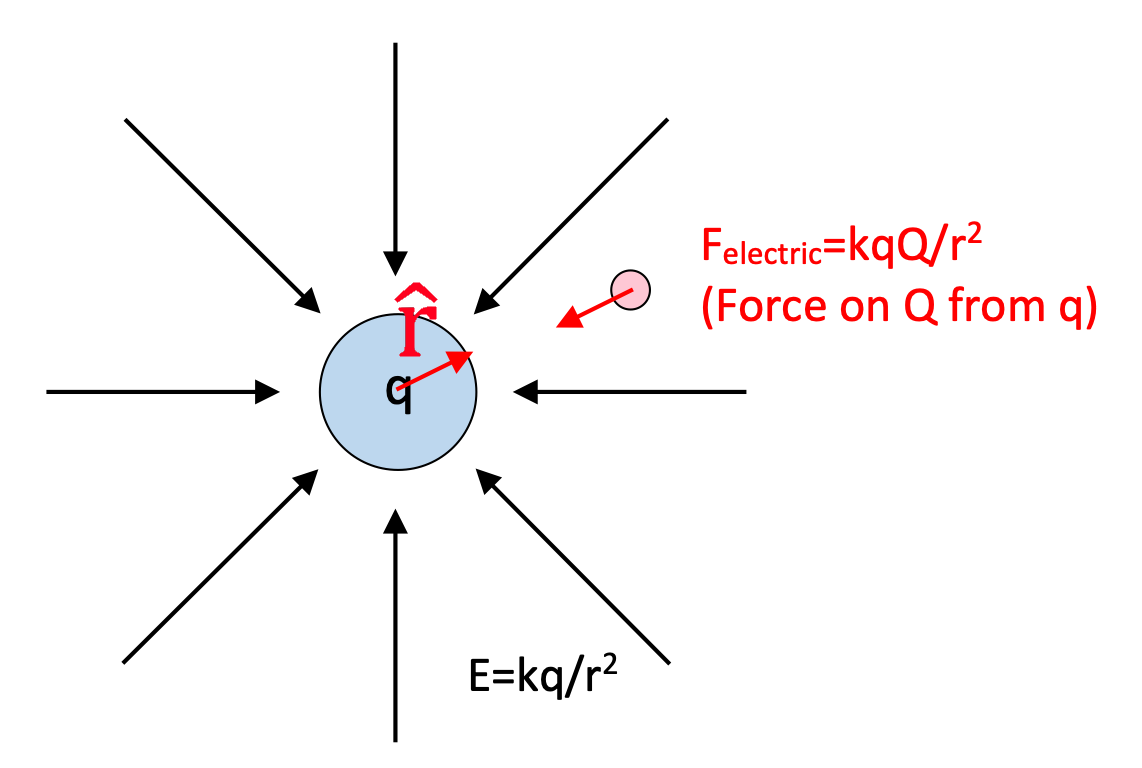
A more formal description of the Electric field includes the vector, where positive
is a unit vector (magnitude of 1) that points away from the source of electric field. If the charge q of the charge is negative, then the Electric field will point in the opposite direction of
, indicating a field that points toward the negative charge. This, in turn, implies a force toward the negative charge on an "always-positive-test-charge" in the vicinity of the field.
The field looks different for a positive charge as a source of electric field, but the principles are the same. A small, "always-positive-test-charge" placed in the vicinity of the large positive charge experiences a force away from that charge, indicating that the direction of the field is also away from that charge.
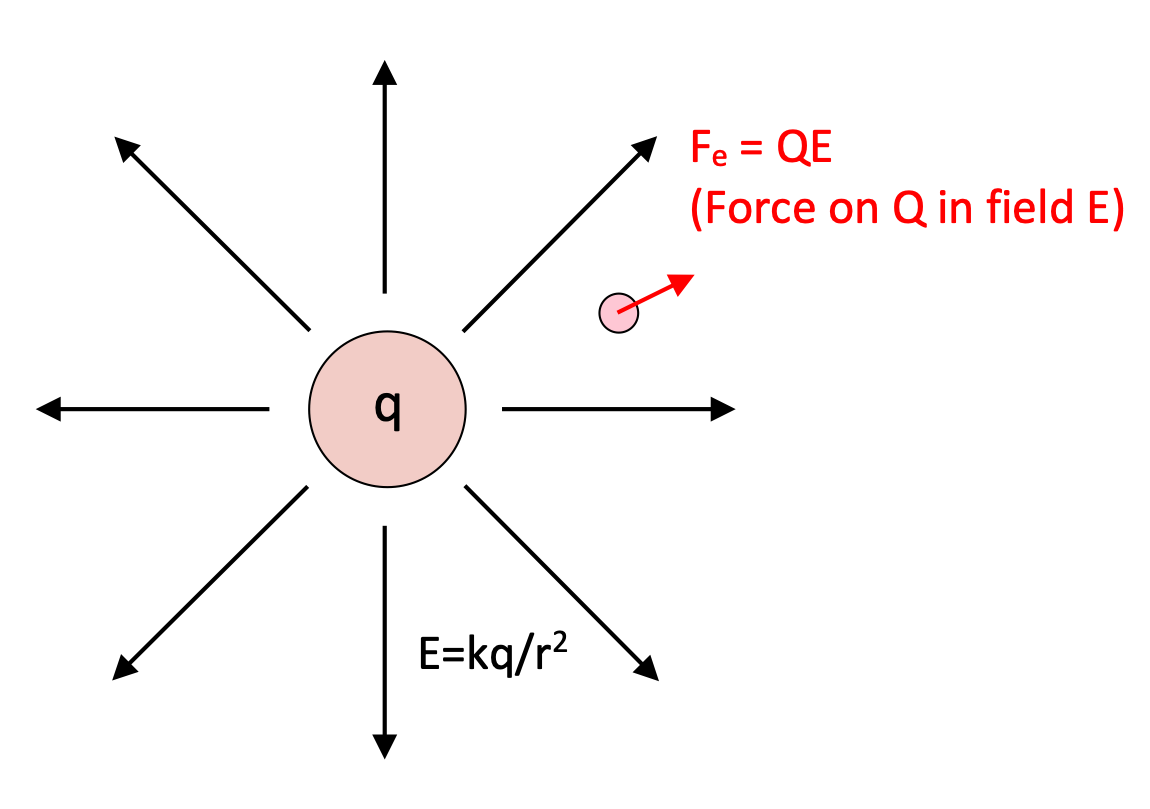
5.2.2. Visualizing Electric Fields
To better understand the electric field effects in a region of space, it's useful to be able to visualize those fields, and there are a couple of different types of diagrams that we can use for that: field vectors, and field lines.
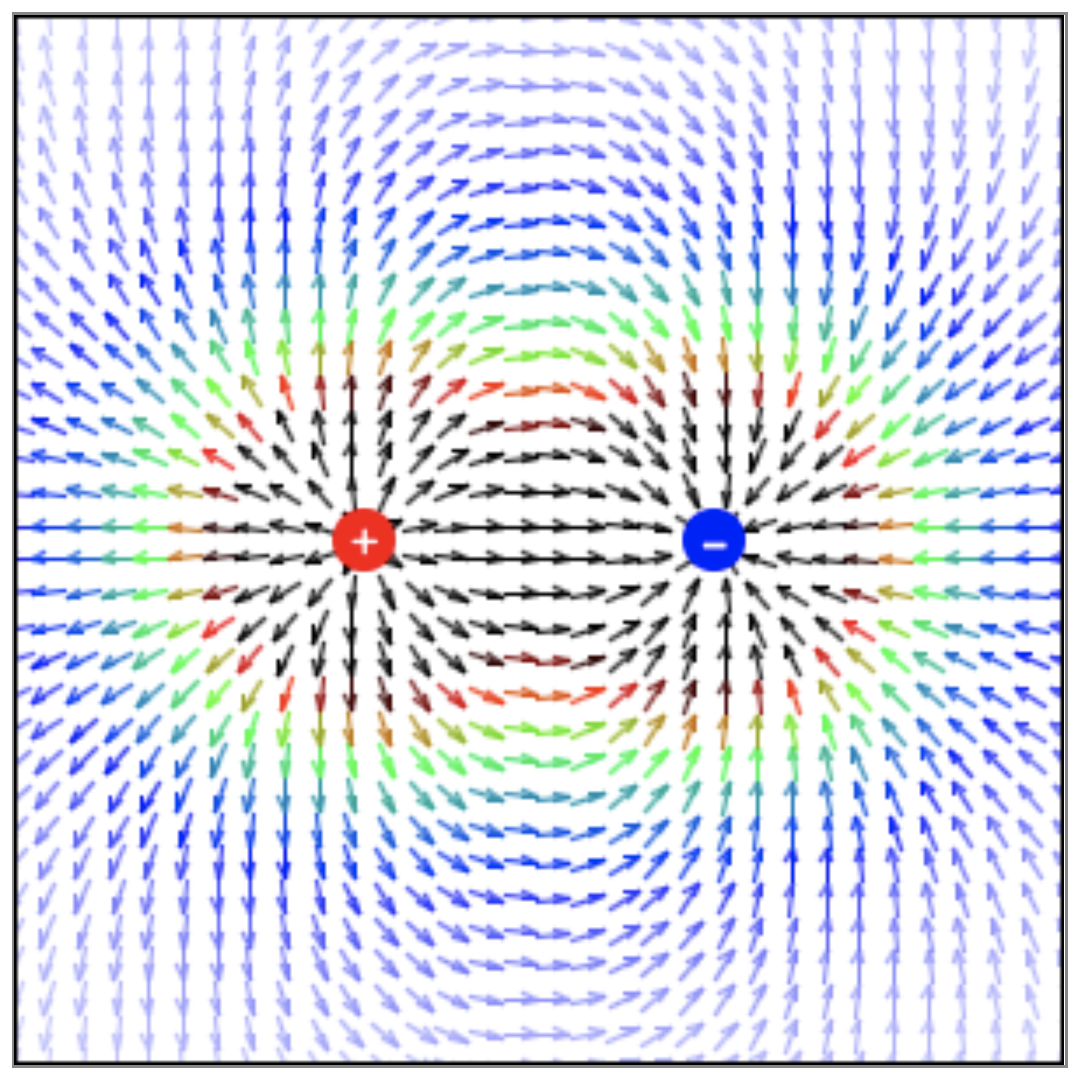

Go to www.compadre.org/Physlets/ and run some simulations to get a better understanding of how electric fields are formed, and how charges behave in those fields.
Also, see http://falstad.com/emstatic for some other outstanding representations of electric fields due to charges.
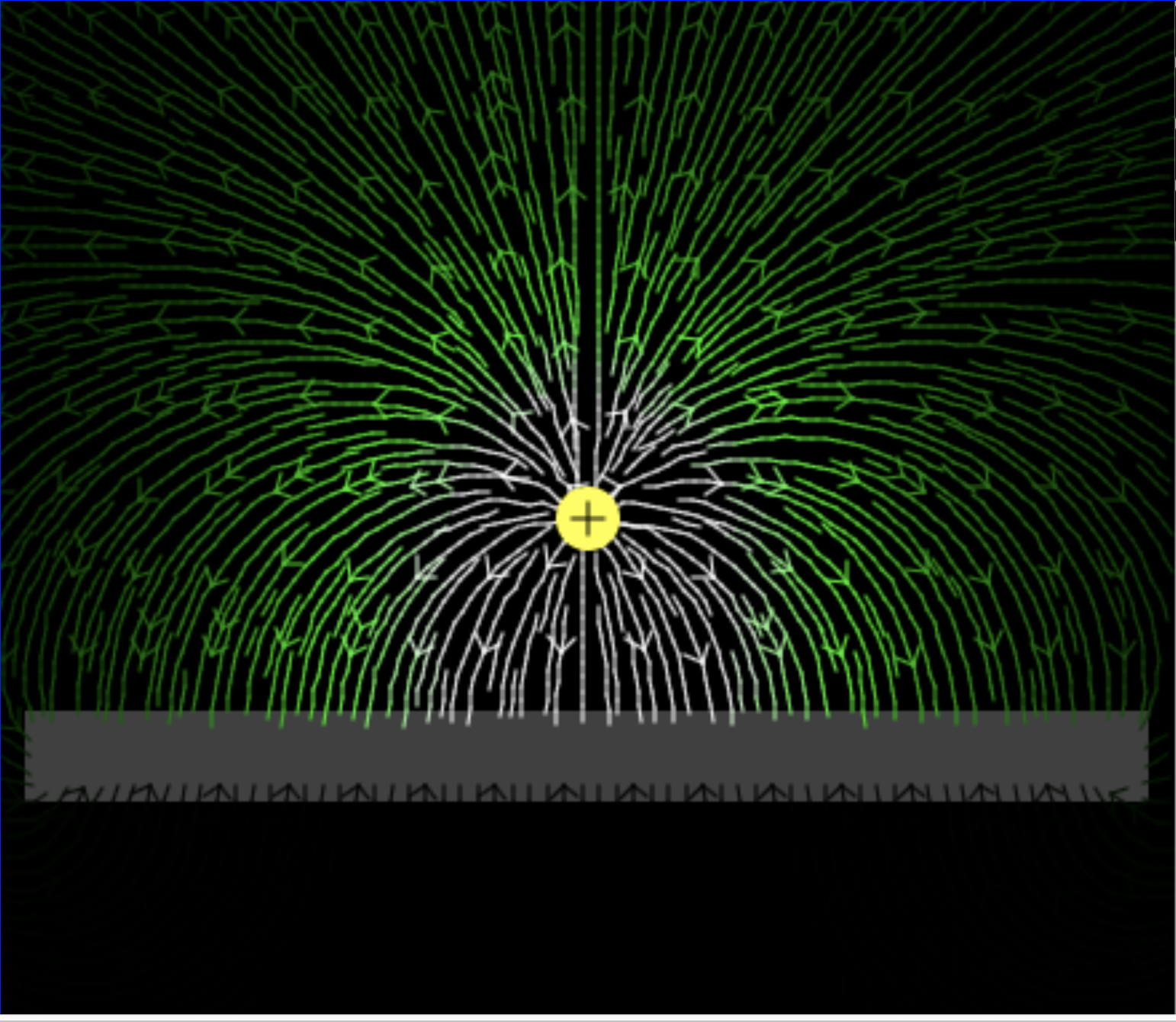

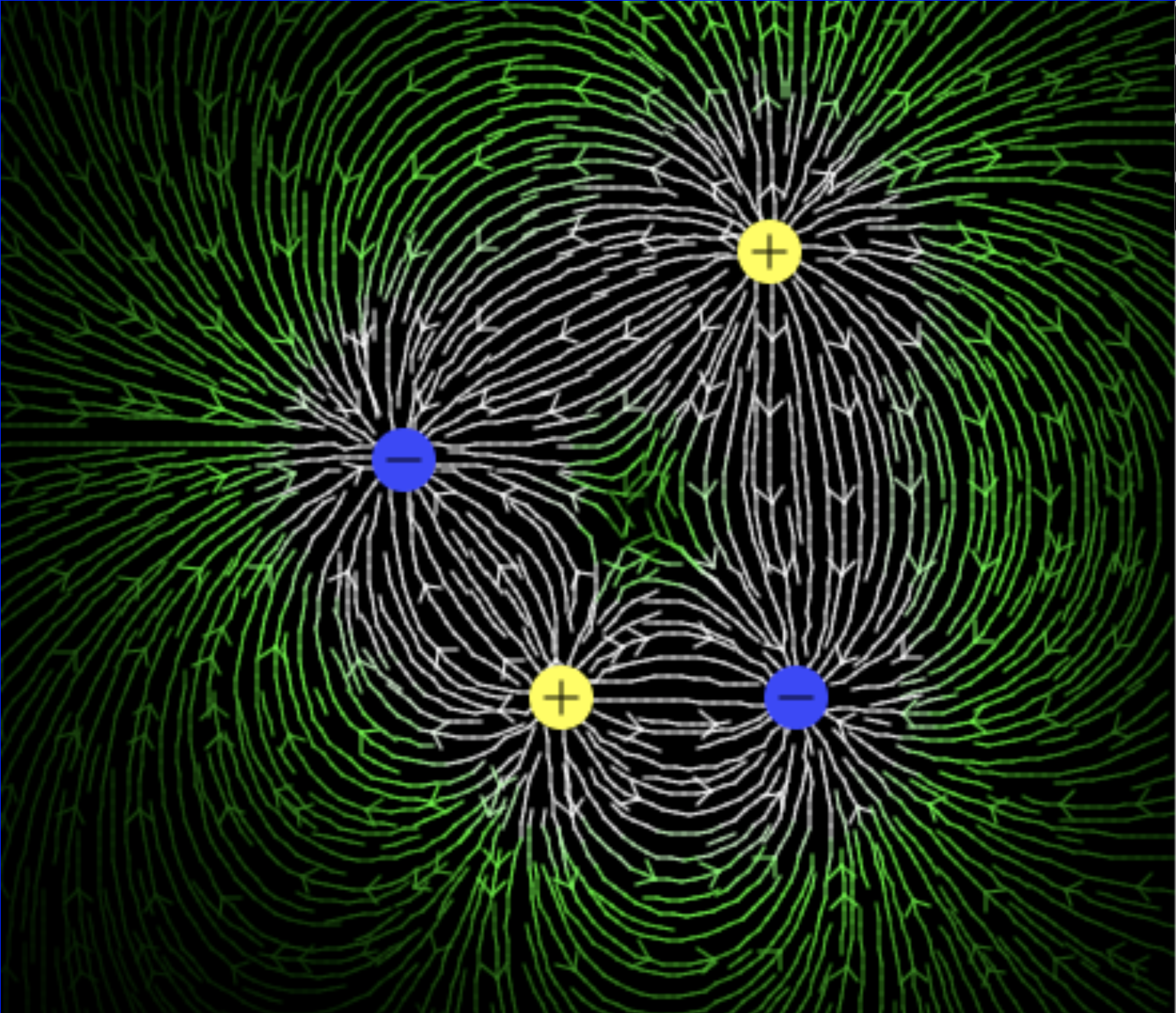
5.2.3. Solving problems
Let's see if we can apply what we've learned to this point.
Electric field of a point charge

A point charge has a charge of -3.0e-6C.
- What is the magnitude and direction of the E field 30 cm to the right of the charge?
- What is the Force (magnitude and direction) on an electron placed at this position?
- How many electrons were deposited on the point charge to give it this magnitude charge?
- 3.0e5 N/C to the left
- 4.8e-14 N to the right
- 1.9e13 electrons
If there is more than a single charge in a region of space, then the electric field at any point is simply the vector sum of the electric field of each charge.
Electric field from multiple charges

A charge, q1 = 7.0 μC is located at the origin, and a second charge, q2 = - 5.0 μC, is located along the x-axis at 0.30 m from the origin. Find the electric field (magnitude and direction) at the point (0, 0.40) m.
What did you get?
5.2.4. Electric field to a continuous charge distribution
Up to this point we've only looked at the electric field in space due to the presence of one or more "point charges." If electric charge is distributed continuously over a larger region of space, we'll usually need a calculus-based strategy to identify the electric field.
Solving for E field of continuous charge

To find the electric field E at a point P due to continuous charge +Q:
- Divide the charge distribution into small elements, each with charge dq
- Use Coulomb's Law to calculate the electric field dE due to each of these charges
- Evaluate the total E field at point P by summing the contributions of all the individual charge elements:
Note that this integral tries to integrate displacement vectors r with respect to charge q, which we can do using a substitution strategy:
How you apply this integral depends on the situation. Here are several important representative examples. Note that there are only a few examples that you will be expected to understand well, because this course only uses single-variable calculus.
Electric field of a charged rod

A rod of length L has a uniform positive charge per unit length λ and a total charge of Q. Calculate the electric field at a point P along the axis of the rod, located a distance d from one end.

Let's consider all the dq bits of charge distributed along the length of the rod, from a distance of d to a distance of d + L, and substitute in the appropriate charge-density relationship.
To identify the direction in this situation, place an small, imaginary, positive test charge at point P. It will experience a force to the left, repelled by the positive charge in the rod. Therefore, the Electric field points to the left, by definition.
E field of a charged hoop along central axis
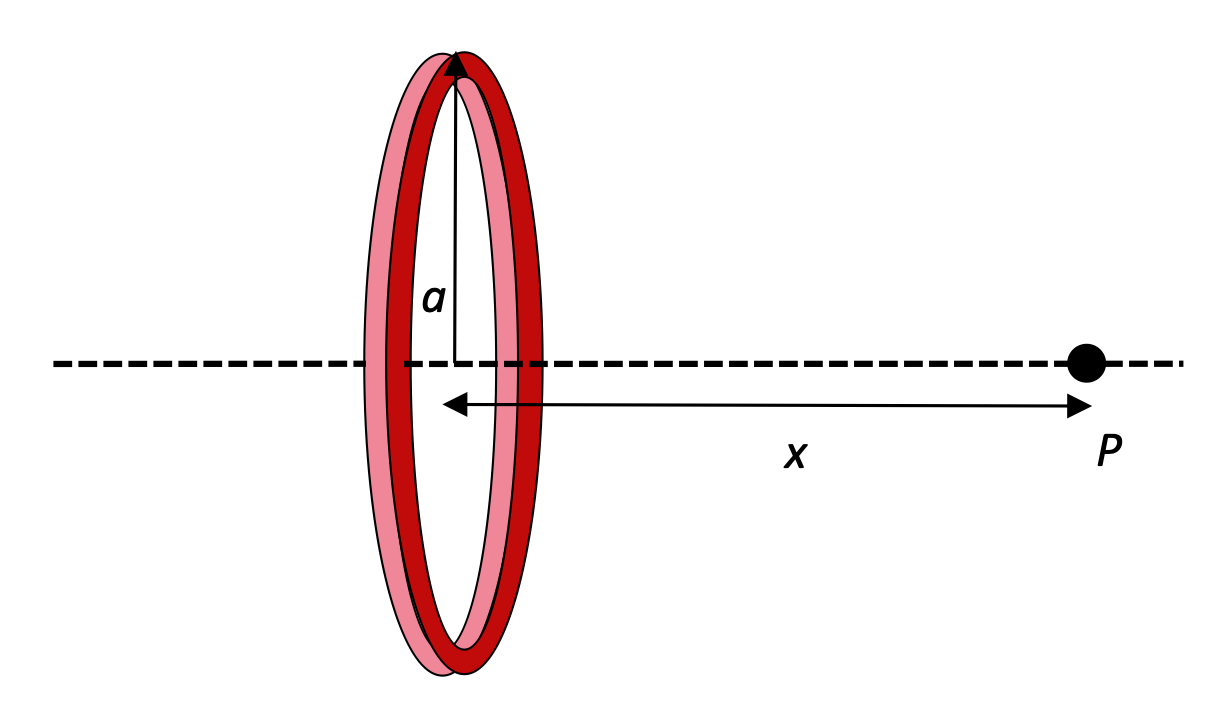
A ring of radius a has a uniform positive charge per unit length λ, with a total charge of Q. Calculate the electric field along the axis of the ring at a point P lying a distance x from the center of the ring.

E field of a curved rod at its center

Assume a rod of length L and continuous charge distribution -Q, curved into a semi-circle of radius R. Find the magnitude and direction of the electric field at the center of the semi-circle.
E field of a charged disk

A disk of radius R has a uniform charge per unit area σ. Calculate the electric field at a point P that lies along the central axis of the disk, at a distance x from its center.

Strategy: consider the disk as a group of concentric charged rings, for which we've already learned how to calculate E.
5.3. Drawing Electric Field Lines
It's a useful skill, to be able to draw your own field diagram in order to better understand the electric field in a given distribution of charges. Some simple rules help with this.
- The number of lines starting on a positive charge or ending on a negative charge is proportional to the magnitude of the charge.
- The closer the lines are together in a region, the stronger the electric field is in that region.
- Field lines indicate the direction of the electric field, because the E field at any position points in a direction tangent to the field line at that point.
5.4. Motion of a Charge in an Electric Field

If you were to throw a ball with a horizontal velocity in the earth's gravity field, you know exactly what would happen. The mass of the ball would accelerate in the direction of the gravity field, even as it continued to move horizontally.
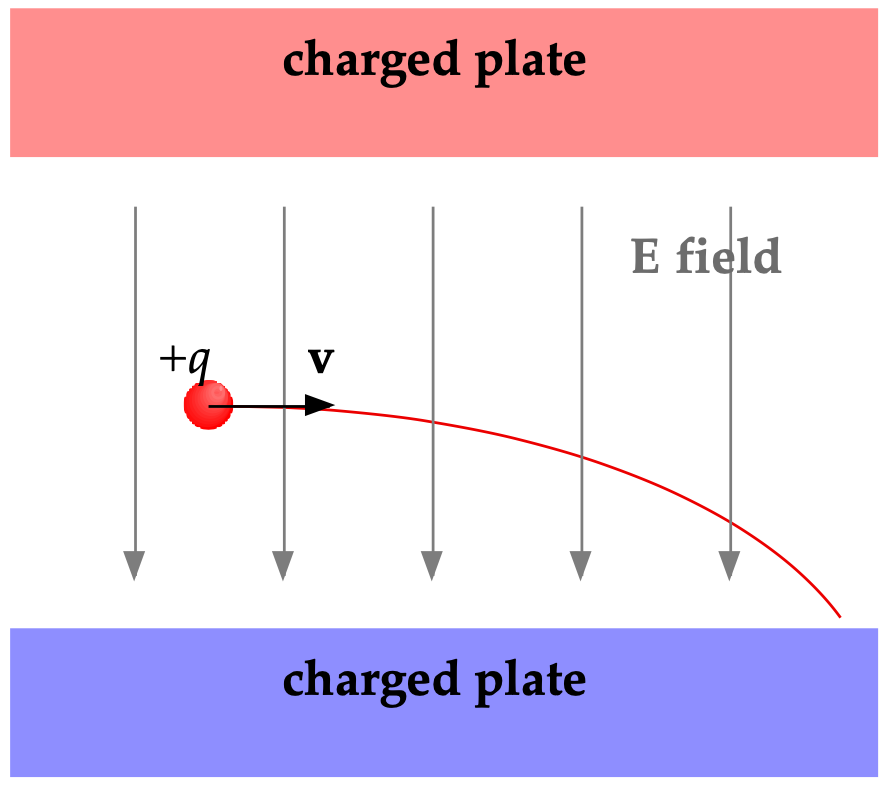
In precisely the same way, a charge of +q, if projected sideways across a constant electric field, will accelerate in the direction of the electric field, even as it continues to move horizontally. Of course if it were a negative charge, it would accelerate in the direction opposite the field.
We can determine the acceleration of the charge by consider the electric field, the force it applies the charge, and the mass of the charge:
For some interactive examples of this, try the following (click image to launch):
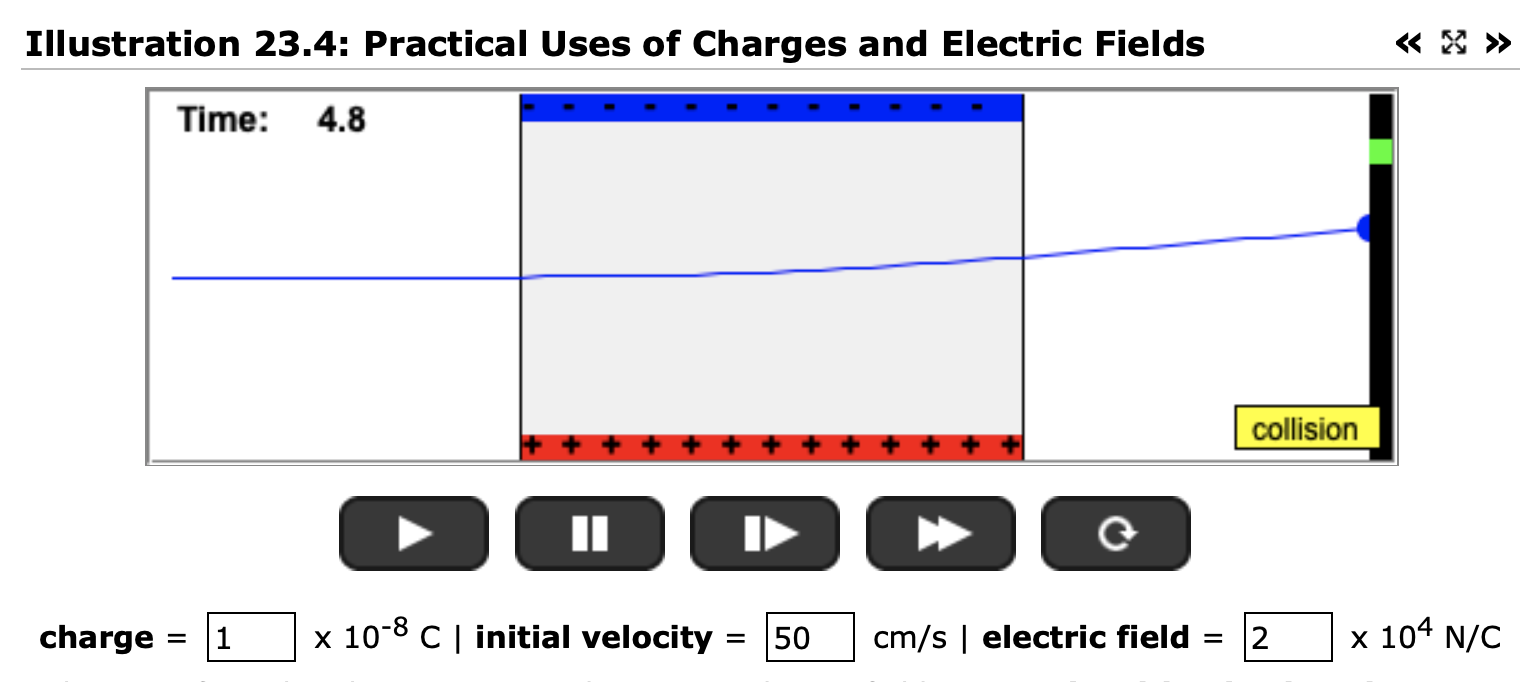
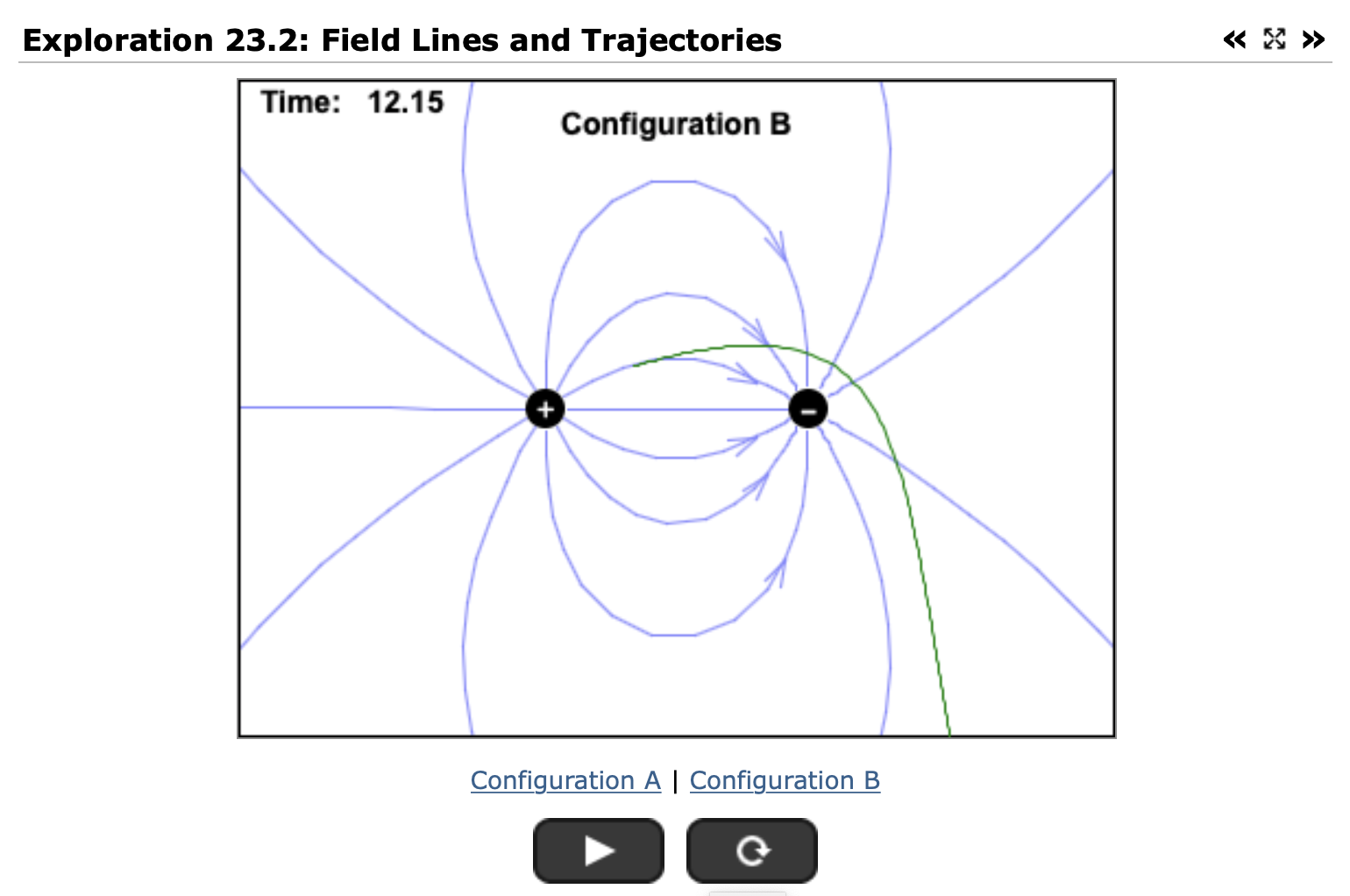
Electron moving through an electric field

An electron is fired as shown, with v0 = 3.0e6 m/s. The E field has a strength of 200 N/C, and the width of the field, from left to right, is 0.100 m.
- Calculate the acceleration, magnitude and direction, of the e- in the field
- Calculate how much time the electron takes to pass through the field
- the vertical displacement of the electron while in the field
- the final speed of the e- as it leaves the field
- Calculate the acceleration, magnitude and direction, of the particle entering the field if it were a proton rather than an electron.
5.5. From the Archives
